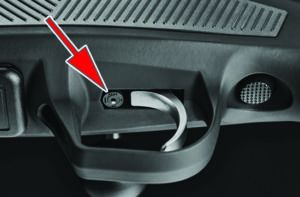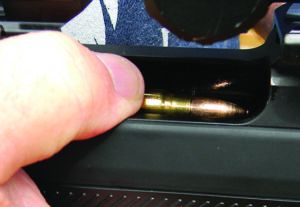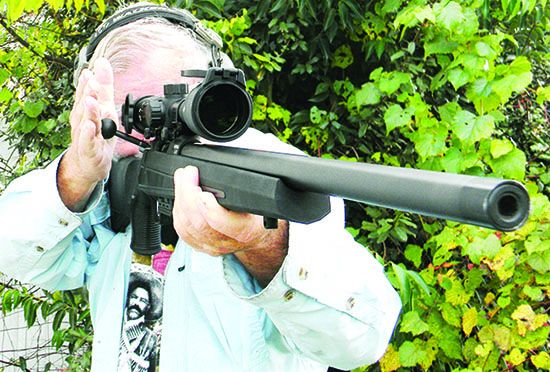Mid-caliber carbines are very popular. Many are chambered in popular offerings, such as 30-06 Springfield, 7.62x39mm (or 7.62 Soviet), 300 Blackout, 308 Winchester, and 30-30 Winchester, to name but a few. These traditional cartridges have proven useful in semi-auto, lever-action, and single-shot handy rifles, and some have been adapted to bolt-action carbines, which like the other action types, can be reliable, fast handling, accurate, versatile, and safe. As a ranch rifle, for instance, a bolt-action carbine can ride with an empty chamber and the bolt partially closed on top of rounds in a magazine and out of battery, then the shooter can work the bolt quickly to chamber a round and fire to drive pests or predators from the property or take medium game at moderate ranges. Also, short, light carbines may not be ideal for personal defense because of their low rate of fire, but they could serve in that role if need be.
We wanted to take a look at 30-caliber bolt guns and find one that compares well in power and overall length to a 30-30 lever gun, with detachable-box magazines that supply similar or greater round counts than lever magazines. We chose two carbines, a new 7.62x39mm model from CZ and a Ruger in 300 Blackout. The CZ 600 Alpha Rifle No. 07403 isn’t offered in 300 Blackout, but it is offered in 7.62×39, which we hoped would offer affordable ammo.
We looked hard at differences in pricing between 300 Blackout and 7.62×39. In quality hunting ammunition with jacketed soft-point bullets, we were surprised that the differences were not that much. In fact, sometimes the 7.62×39 was more expensive. We reasoned that not a lot of hunters use the AK rifle cartridge to hunt, so it cannot be a big seller as a deer round. In full-metal-jacket loads, however, the 7.62x39mm was much less expensive. We found some 7.62×39 ammunition for $4.40 for 20 rounds, or 22 cents a round. Nothing in 300 Blackout could touch that price. The best price we found for 300 Blackout FMJs was $12 for 20 rounds, or 60 cents a round. Fiocchi 300 Blackout FMJs, 50 rounds, were $43 (86 cents per round). In other bullet types, we found Hornady Black 7.62×39 123-grain SSTs at $30 for 20 rounds ($1.50 per round), while Hornady Custom CX 110-grainers in 300 Blackout were $32 ($1.60 per round). In muzzle energy and velocity, the 7.62×39 beats the 300 Blackout across the board, as the Range Data table shows. The only real advantage 300 Blackout holds is the ready availability of subsonic ammunition for suppressor use.
These rifles were each noted for low recoil. While one stock handled recoil better, each of these rifles is easily rated as a light kicker compared to a 30-30 WCF or 308 Winchester. Yet with proper loads, either is qualified as an American deer rifle. The 30-30 is often hailed as a baseline for power in taking deer-sized game, but in our experience, the 30-30’s performance deficit in lever guns is more about accuracy than power. Old-style buckhorn sights common on lever guns are hard to shoot accurately, so shot placement suffers. Modern bolt-action carbines are easily scoped and, in most cases, offer good accuracy. We fitted the CZ with a SIG Buckmaster 3-9×40 optic, an affordable riflescope that has given good results on other rifles. We used a Vortex 3-9×40 Crossfire II on the Ruger.
One of our test guns, however, wasn’t that accurate, as you can read below.
CZ 600 Alpha Rifle No. 07403 7.62X39mm
$665
Gun Tests grade: A
Seldom has a rifle so easily overwhelmed the competition. And good competition at that. The Alpha is very smooth in operation and feeds well. The Alpha proved to be light kicking, accurate, and ergonomic. The CZ Alpha is a good introduction and among the best rifles we have tested in some time.

| Action Type | Bolt |
| Overall Length | 43.1 in. |
| Barrel | 18 in. long, 1-in-9.5 twist |
| Overall Height w/Scope | 6.75 in. |
| Weight Unloaded | 6.6 lbs. |
| Weight Loaded | 7.1 lbs. |
| Action Finish | Black |
| Barrel Finish | Black |
| Magazine Capacity | 5 rounds |
| Stock | Synthetic |
| Drop at Comb | 0.6 in. |
| Drop at Heel | 0.85 in. |
| Bedding | Metal pillars |
| Buttpad | Soft rubber |
| Length of Pull | 14.1 in. |
| Scope Base Type | Integral mount |
| Trigger Pull Weight | Adjustable |
| Warranty | 5 years |
| Telephone | (800) 955-4486 |
| Website | CZ-USA.com |
| Made In | Czech Republic |
The new CZ 600 series rifles are available in wood-stock versions (American, Lux, and the laminated Range) in major rifle chamberings such as the 308 and 30-06, and also in smaller chamberings from 223 to 6.5. The 300 Blackout is only available in the Trail model, with a collapsible stock. The wood stock premium rifles retail at around a thousand dollars. The 600 Alpha rifle with a synthetic stock tested here is light enough at 6.6 pounds but is heavier than the Ruger, likely a result of its 18-inch semi-heavy barrel.
The rifle’s receiver is robust. The bolt is designed with a 60-degree lift. The stock is ergonomically designed with more complex angles than the Ruger and offers good handling. The line of sight is more natural to acquire than the Ruger, we thought.

The magazine is detachable, easily removed, and easily replaced, and the magazine release is intuitive. The CZ five-shot magazine is not an AR type. Because of the controlled-feed bolt, loading the CZ from the top of the receiver was easy. Simply pressing three cartridges in from the magazine top was simple enough during benchrest fire. The 18-inch barrel is threaded for suppressor or muzzle brake use, and the CZ Alpha features a monolithic top rail, so mounting optics is simple.
An advantage of the CZ Alpha is the fully adjustable trigger. While the Ruger is also adjustable, we were able to run the CZ down to a super-sharp and crisp 1.3 pounds. While some shooting was done at the issue 2.5 pounds, we moved it back up to 2.0 pounds during the test. From the bench, there really wasn’t much difference with the lightest trigger setting; we were able to fire the rifle well from a rest. Offhand is where we felt the advantage. Even better, the CZ does not require disassembly to adjust the trigger. The trigger is easily set with a screw in front of the trigger guard.
The team discussed the manual safety at length. Some liked it and some didn’t. The consensus was that with practice, the CZ safety is very nice to operate. The safety is a bolt behind the action. It is thumbed down for Fire and was very positive in operation. To make the gun Safe, you press from under the stock. Because you cannot see the safety bolt, placing the gun on Safe is less intuitive. Still, the safety is novel and worked well throughout the test. We thought the Ruger was easier to operate.

We worked the rifle a lot in dry-fire operation prior to live-fire testing. We found the action to be very smooth. Next, we engaged in 50-yard speed-shooting drills. The CZ ran smoothly and never failed to feed, chamber, fire, or eject. We felt the Ruger simply wasn’t in the same class as the CZ Alpha in smoothness and speed shooting. The combination of a smooth bolt throw and ergonomic stock simply walked away and left the Ruger. We estimate we could make five hits with the CZ in the same time it takes to make three equally good hits with the Ruger.
Settling into the benchrest portion of the test, we did not have particularly high expectations of the accuracy with the 7.62×39 cartridge, even in a bolt gun. The CZ was more accurate than expected. Hornady Black 7.62×39 was a great shooter, with three shots into an 0.8-inch best group, although the average for three groups was slightly larger. This is exceptional performance for a carbine. AK rifles of the general run may be good for a 4-inch group, some worse, and a top-quality AK, such as the Arsenal, may put three shots into 2 inches at 100 yards.
Our Team Said: The accuracy exhibited by the CZ 600 Alpha is exceptional for any chambering. One of our raters also tested the rifle with inexpensive steel-case loads, and it still was running 2.0-inch groups. The CZ Alpha is an exceptional rifle in every aspect.
| RANGE DATA | |
| Hornady Black 123-grain SST 80784 | CZ Alpha 600 Rifle 7.62x39mm |
| Average Velocity | 2330 fps |
| Muzzle Energy | 1483 ft.-lbs. |
| Smallest Group | 0.8 in. |
| Average Group | 1.2 in. |
| Tula Steel Case 124-grain HP UL076230 | CZ Alpha 600 Rifle 7.62x39mm |
| Average Velocity | 2355 fps |
| Muzzle Energy | 1527 ft.-lbs. |
| Smallest Group | 1.3 in. |
| Average Group | 1.6 in. |
| Federal American Eagle 124-grain FMJ A76239A | CZ Alpha 600 Rifle 7.62x39mm |
| Average Velocity | 2290 fps |
| Muzzle Energy | 1443 ft.-lbs. |
| Smallest Group | 0.9 in. |
| Average Group | 1.3 in. |
How we tested: We fired groups at 100 yards from a benchrest position using an MTM Case-Gard K-Zone Shooting Rest. We used a Competition Electronics Pro Chrony to measure muzzle velocities. Notes: TSX = Triple-Shock X copper bullet.
CX = Copper alloy eXpanding bullet. BSP = bonded soft point. SST = Super Shock Tip bullets, polymer tip. HP = hollow point. FMJ = full metal jacket.
Written and photographed by Gun Tests Staff, using evaluations from Gun Tests Team members. GT




























